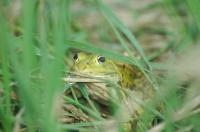
The marsh frog (Rana ridibunda) Indigenous water frogs can be crowded out by immigrant or imported species. This is the finding of a Franco-German study. The scientists investigated water frog populations in France and Northern Spain and noticed that the marsh frog (Rana ridibunda), which normally occurs only in Eastern Europe, has the potential to crowd out indigenous species like Graf’s hybrid frog (Rana grafi) and the Iberian water frog (Rana perezi).
The scientists believe this ability is related to the fact that the marsh frog lives longer and grows faster than the indigenous species. In addition, the female marsh frogs produce more progeny than their competitors, the researchers write in the scientific journal Comptes Rendus Biologies. The marsh frog has now spread from Central Asia as far as France and Spain. This latest spread is attributed to imports of live animals for culinary purposes. As the foreign species mix with the indigenous species, the indigenous water frogs are being pushed back into just a few areas. Imports of invasive species by humans are regarded as one of the main threats to species diversity on earth, alongside climate change.
Most stable marsh frog populations in France and Switzerland originated from frogs bred for gourmet restaurants or imported directly from various source countries. The frog fauna along larger river flood plains in both countries has now altered significantly in favour of the new frog species. Until now though, it was not clear why the new species had been able to establish themselves in the face of the indigenous species. The team of scientists investigated over 700 water frogs from 22 locations in the Rhone drainage basin in France and four locations in the Ebro drainage basin in Spain. "We noticed that the introduced marsh frog has a high competitive potential, particularly in high-oxygen, low-salinity freshwater. In these conditions the indigenous frogs hardly stand a chance," declares Dr Dirk Schmeller of the Helmholtz Centre for Environmental Research (UFZ). The displacement process is linked to the fact that the marsh frog grows faster than the indigenous frogs, and is in direct competition for food. In addition, female marsh frogs live longer and are more fertile. This means that over the course of their lives they produce significantly more progeny, thereby crowding out the other frog species. The number of progeny is increased still further because when the marsh frog mates with Graf’s hybrid frog (Rana grafi) or the edible frog (Rana esculenta), it produces marsh frog progeny. This may sound astounding, but can be attributed to a special type of reproduction called hybridogenesis, which is a special feature of water frog reproduction. All these factors may lead to the extinction of the indigenous water frog species, the researchers believe, and therefore recommend that the spread of the marsh frog be closely monitored.
Source : Helmholtz Association of German Research Centres
 Print Article
Print Article Mail to a Friend
Mail to a Friend
